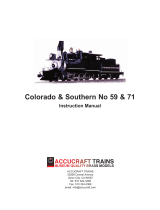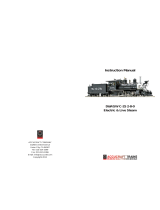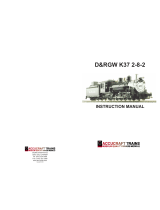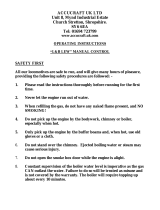Page is loading ...

ACCUCRAFT COMPANY
33268 Central Avenue
Union City, CA 94587
Tel: 510-324-3399
Fax: 510-324-3366
Copyright 2014
Instruction Manual
SOUTHERN PACIFIC
2-6-0 M-6
ELECTRIC

Instruction Manual SP 2-6-0 M-6
Prototype Information
Steam Locomotive Numbers 1727 and 1744 were built by the Baldwin Locomotive
Works in Philadelphia, Pennsylvania in November 1901 for the Southern Pacific
Railroad. The locomotives entered regular service in December 1901. They were
originally a Vauclain Compound having one low and one high pressure cylinder
per side in an arrangement pioneered by Samuel Vauclain. This compound design
was an early attempt to utilize steam more efficiently by cycling it twice through
the cylinders. It proved costly to maintain. In addition, the heavy pounding of the
rods and crossheads due to the unequal pressure caused them to be very hard
on the track and a rough ride for the crew members. The Southern Pacific (Espee)
took the hint and they converted to simple operation. To further upgrade the
locomotives, they were superheaded in 1908.
Southern Pacific Mogul Class M-6 2-6-0 weights 174,000 pounds (87 tons) ready
for service, has 63” driving wheels, 21”x28” cylinders, Stevenson valve gear and
a tractive effort of 33,200 pounds. Her boiler is rated for 200 pounds of steam
pressure. Both models use class 90C tenders.
These engines worked all over the Espee (SP) Pacific Lines system, but spent
most of their careers in California. Mogul locomotives were originally built for
and used in general freight service, however, as the years went by and trains
got heavier and longer they were relegated to lighter duties such as secondary
freight and passenger trains, branch line locals and yard switching duties. The M-6
was found to be excellent for working on light rail, in tight clearances and on the
curvature found around industries and packing houses. They had the reputation of
being able to “fit through a keyhole”. The crews liked them for their smooth ride,
and they were known to be easy on fuel oil and water. They could haul fifty or
so loaded refrigerator cars and run up to 65 miles-per-hour. On the San Joaquin
Division, they earned the nicknames of “Fresno Malley” or “Valley Malley” as they
could pull as much freight in the California valleys as a true Mallet could pull in the
California hills.
On May 21st, 1999, the Rio Grande Pacific Corporation’s subsidiary company
Gandy Dancer Incorporated purchased the Ex-Southern Pacific 1744. Under the
direction of their director of Steam Locomotive Operations Joe Dale Morris, The
locomotive was completely restored to operating condition. When all required
maintenance work and restoration work was completed, the 1744 was sent to
the Rio Grande Pacific’s subsidiary New Orleans & Gulf Coast Railway of Belle
Chasse, Louisiana. the 1744 was operated in regular recreational train service for
a short time and then was put up for sale.
1
Instruction Manual SP 2-6-0 M-6
NOTES:

Instruction Manual SP 2-6-0 M-6
NOTES:
Instruction Manual SP 2-6-0 M-6
General information about outhern
Pacific M-6:
This accurately detailed model is con-
structed of brass and stainless steel.
Pittman gear head motors power all 6
drivers. The museum quality fi nish and
lettering represents this locomotive as
it would have looked in the mid 1950’s.
Your Accucraft M-6 has a new style
power distribution board in the tender.
To gain access to the inside of the ten-
der all the 1.6 hex bolts will need to
be removed around the outside of the
semi Vanderbilt tank and also the rear
handrail 1.6 bolts, and carefully dis-
connect the front handrails down low
on the ladder.
Track power is routed through this
board to the motors. An aftermarket
sound system also gets its power from
this board. Please refer to the wiring
Diagram at the rear of this manual.
The lights on this locomotive are LEDs
rated at 6 volts.
Your locomotive and tender are elec-
trically connected via 12-prong plug at
the rear of the locomotive, under the
rear deck.
The plug takes the place of the usual
“wireless drawbar” that has tradition-
ally been found on metal locomotive
models. The drawbar on this model
is just what its name implies; a draw-
bar only. Power is routed from front to
back and vice versa via the 12-prong
plug.
Both locomotive and tender units have
carbon brush pickups on both rails, to
ensure reliable operation when using
track power.
Disassembly on this large and complex
model is not recommended. However,
if absolutely necessary, the 1.6mm
hex bolts and nuts can be turned with
a nut driver sized for U.S. 00-90
Your 2-6-0 is designed to run on a 48”
minimum radius curve track.
Please take care in lifting this large
and heavy model. It is recommended
that the locomotive be picked up by
grasping it under the frame on both
ends.
2

Instruction Manual SP 2-6-0 M-6
3
Model Features:
This limited production model has
been handcrafted for Accucraft Trains
by BMMC, which is one of the most
respected makers of large scale brass
models. This museum quality model
features:
• Full cab interior details, with oper
ating cab windows.
• Detailed boiler with fi ttings,
domes, pipes and handrails
• Operating steel drive rods, valve
gear and cross heads
• Prototypical livery and lettering
• Steel helical gears in a die-cast
transfer box
• Pittman motor
Technical Specifi cations:
Scale 1:32
Gauge 45 mm
Mini. Radius 48 in.
Dimensions 28.54x3.75x5.79 in.
Power 0~24V DC
*Be sure to leave at least 3” clear-
ance (measured from the inner rail) to
allow for overhang.
Caution!
This model is an accurate replica of the original locomotive. It has sharp and
moving parts. The locomotive drive rods are stainless steel with sharp edges.
OPERATORS MUST NOT COME IN CONTACT WITH A MODEL THAT IS
BEING POWERED AT ANY TIME. UNDER NO CIRCUMSTANCES SHALL
ACCUCRAFT TRAINS BE RESPONSIBLE FOR ANY INCIDENTAL OR CON-
SEQUENTIAL DAMAGES ARISING IN REGARD TO ANY ACCUCRAFT
PRODUCT.
Instruction Manual SP 2-6-0 M-6
8

Instruction Manual SP 2-6-0 M-6
7
SP 2-6-0 M-6 Electric Diagram
Instruction Manual SP 2-6-0 M-6
4
Lubrication:
Please lubricate your Accucraft Model
before attempting to operate.
With a bit of care, your Accucraft
Model should give you many years
of pleasure and reliable service.
Lubrication is of prime importance on a
model of this type with so many moving
parts. Always use quality lubricants.
This should not be a problem, for there
are many modern lubricants available
in hobby and sport shops. Light oil
such as Labelle #108 or Hoppe’s Gun
Oil will do a good job on lubricating
most of the moving parts. For pistons
and slides, a heavier lubricant such as
Labelle #102 would suffice. For gears
use gear grease such as Permatex
Super Lube or another hobby gear
lubricant.
To access the many moving parts of
this model: Using a soft towel or foam
sheet, the model should be carefully
placed on its side. A drop of light oil
on every moving part is necessary;
there are many moving parts on this
locomotive. Be sure to lubricate all the
crank pins, crosshead slides, piston
rods, etc. that is visible to you. Make
sure you lubricate the locomotive and
tender axle’s journals as well.
Do not over lubricate, since excess oil
only picks up unwanted dirt. Be careful
to keep lubrication off the painted
surfaces to avoid having shiny areas.
Use a type of oil that is a bit heavier to
lubricate the axle bushings and pivot
points of the lead and trailing trucks.
The main gear box is lubricated in the
factory, and will not require any atten-
tion when you first run your model.
However, in time; you should make
sure that the gears are well lubricated
with some technical gear grease. The
gear box cover is held on with screws,
and removing it will allow you to
access all the gears and busings that
need lubrication. Take note of how the
cover comes off and replace it exactly
the way it was when you started.
Lubrication of the locomotive should
be done every 25 hours of operation.
After following the recommended
lubrication procedures, your Accucraft
2-6-0 is ready to provide many years
of reliable operation.
We recommend that you use a D.C.
power supply with a capacity of 2.5
amps or larger and 24 volts output.
Always pick your model up by grasp-
ing it under the frame on both ends. It
is a very heavy model so make sure
you grasp it firmly.

Instruction Manual SP 2-6-0 M-6
Electrical Pickup
Your Accucraft model is powered by
the DC voltage off the track through
the engine and the tender. All driv-
ers are insulated on the both side of
the locomotive, and the electricity is
picked up with 12 pickup wheels.
Be sure to clean electrical pickup units
before each operation. Replacement
electrical pickup units can be ordered
from Accucraft Trains.
Lighting
This model features directional light-
ing.
General Maintenance:
Clean the exterior surfaces of your
locomotive with a clean, soft and lint
free cloth. To remove stubborn soil
or greasy spots from the painted sur-
faces use alcohol on a soft, lint free
cloth.
Accucraft Trains locomotives are fine
scale brass models with small parts.
To provide maximum protection from
shipping damage, we carefully pack
the models in metal cases, We ship
via UPS with insurance coverage to
its full valve. Please contact UPS if
package is damaged.
Each locomotive is packed under
UPS guidelines for shipping. We do
not warrant any damage resulted from
re-packing by any party other than
Accucraft Trains
.
5
Instruction Manual SP 2-6-0 M-6
6
Please read following directions be-
fore unpacking your locomotive.
1. Remove foam around the locomo-
tive. Slide the inner box cover to the
side, and open the inside cardboard
box with a cutting knife.
2. Lift the metal case from the card-
board box.
3. The locomotive is fi rmly taped to a
½” wood board which is then fastened
to the metal case with 4 M6 bolts.
Bolts must be removed before lifting
the locomotive with wood board from
the metal case.
4. Place taped locomotive on a fl at
surface. Carefully cut the tape along
the wood board side surface. Be sure
to cut both sides of the wood board.
Slowly lift the tape from the locomo-
tive. Be very careful with small parts.
Tape cannot be re-used to re-pack the
model. Use new packing tape if nec-
essary.
/
















